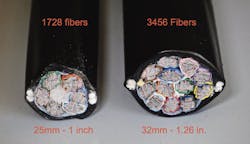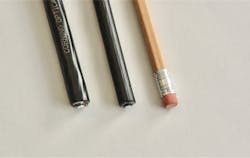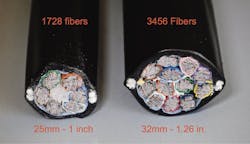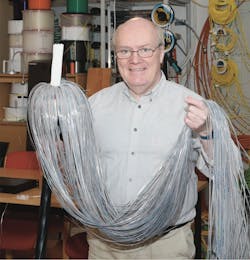Is it Time to Update Your Gear for the New Year?
It’s the new year, time to reflect on the past and think about the future. Make some resolutions that are well meaning but often hard to keep—you know the ones! But let’s focus instead on fiber optics. We should review some recent changes in technology and think about what the fiber optic contractor or installer needs to know to keep up with our fast-moving technology and marketplace.
What’s changing? Cables are changing. They are getting much denser—both smaller for the usual number of fibers as well as larger for higher fiber counts. Service providers want more fibers, especially for crowded urban ducts and data center interconnects where cables are now available with 1728, 3456 and 6912 fibers. OSP cables are more likely to be smaller than the ones for data centers because of the difficulty of installation of the very large cables in ducts, but a few metro areas are using 864 and 1728 fiber cables.
These high-density cable designs began with microcables, especially in the 144 or 288 fiber versions, which can be blown into microducts only about 0.5 inch in diameter (See Figure 1). Microcables and microducts are gaining popularity in urban areas because the installation is cheaper and much less disruptive than with traditional underground cables.
All these high-density cables share some design features. Most are flexible ribbon designs based on bend-insensitive fibers which can be rolled up tightly in buffer tubes. In fact, my “insider information” is that the hard ribbon designs of the past are soon to be extinct. The other design “features” that make cables smaller are thinner jackets and smaller strength members or none at all.
Even the fibers are being downsized to pack more fibers into a cable. The glass fiber is still 125 microns outside diameter but the primary buffer coating, which has been 250 microns OD for forever, is being downsized to 200, or even 160 microns. There is also talk of reducing the glass fiber size too, but that does not seem imminent.
All these new designs are great for installing more fibers, something everybody wants now, but they do have some negative issues too. In the past, cables were often over-designed; able to withstand higher pulling tension, more crushing loads and were less sensitive to bending beyond the specified minimum bending diameter (See Figure 2).
Some of these new high-density cables are not as forgiving of mishandling during installation, according to what I hear from some of the field application support people I know. We’ve heard reports of fibers being broken during installation because of violations of pulling tension and/or bend diameter.
With the big cables, the minimum bend diameter can be larger than current tools being used to pull cables. An 864-fiber cable may have a 30-to-40-inch minimum bend diameter. How many contractors have pulling capstans, sheaves or quadrant blocks large enough for that cable? Larger installation equipment is now becoming available and will be needed if the contractor is going to be handling these larger cables.
Many of these cables, especially microcables, are designed for installation by blowing not pulling. While blowing cables has been used worldwide for years, it’s still new to most contractors and installers in the U.S. While there are only a few suppliers of blowing equipment, they do seem to offer training and it’s something everyone should be learning.
The next issue with these cables is splicing (See Figure 3). Since all are ribbon cable designs with flexible ribbons and most have very high fiber count, ribbon splicing is the splicing method of choice. Trying to splice a high fiber count cable with a single fiber splicer would take too much time; ribbon splicing is about six times faster.
When it comes to choosing a fusion splicer for these fibers, you also have to consider that you will have cables with fibers that have coating diameters of 250, 200, 180, and (maybe soon) 160-micron coating diameters. When splicing cables, you may have to mix fiber coating sizes. The ribbon fusion splicer you choose should be able to handle the different coating diameters, different types of flexible ribbons and even hard ribbons, all of which you may encounter in the field.
You probably also need to look at your tools. My fiber toolbox I used for training is big. I had a half dozen different cable jacket strippers and at least as many fiber strippers—Millers, NO-NIKs, and Micro-Strips. Specialized tools for jobs like midspan access. Crimpers, scribes, knives, pliers, the list of tools goes on and on. I also often have components, tools and equipment loaned from manufacturers for evaluation. As the FOA’s person coordinating the development of training curriculum for our worldwide network of hundreds of schools, I try to personally test anything new.
I recently discovered my trusty old cable jacket stripper was not large enough to strip an 864-fiber cable—its diameter was too large. I had to resort to a lineman’s knife to remove the jacket.
All fiber optic contractors and installers are faced with the same situation. Keeping up with all the changes occurring in fiber optics is necessary to remain competitive in today’s marketplace. Magazines like ISE and websites like theirs are important sources of information that can help you keep up to date on fiber optic technology.
It’s not just knowing what’s new that’s important. It’s important to know when it’s time to retire old tools and equipment and replace it with the new generation of gear. And as you replace the gear, it’s also important to learn how to properly use this new gear, which means taking advantage of the training manufacturers provide.
About the Author
Jim Hayes
Fiber Optic Expert
Jim Hayes is the Fiber Optic Expert columnist for ISE Magazine. He is a lifelong techie who has been involved in the fiber optic industry since the late 1970s. He founded one of the world's first fiber optic test equipment companies, FOTEC, which was acquired by Fluke in 2000, and he was a co-founder of the Fiber Optic Association (FOA), the international professional society of fiber optics, in 1995.
Jim is a writer and trainer and the President of FOA. He is the author of nine books on fiber optics and cabling and writes for several magazines.
Jim and his wife, Karen, who is the GM of the FOA, have traveled the world for the FOA helping set up schools to train the workers who design, build, and operate today's communications networks. The FOA offers nearly 1,000 pages of online technical materials, over 100 videos, and two dozen free self-study courses online.
For more information, email [email protected] or visit www.jimhayes.com.
To learn more about The Fiber Optic Association, visit www.thefoa.org. Follow them on Facebook: FiberOpticAssociation, LinkedIn: company/the-fiber-optic-association-inc-foa, and YouTube: user/thefoainc.




